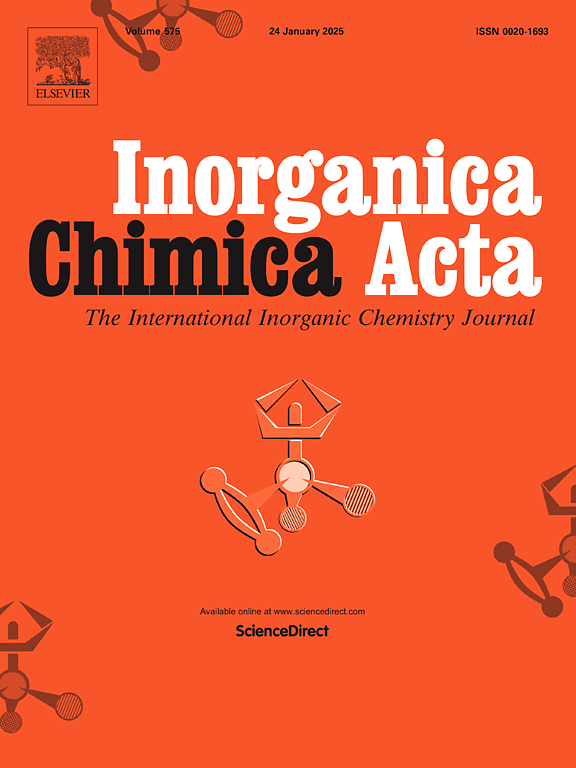IF 2.7
3区 化学
Q2 CHEMISTRY, INORGANIC & NUCLEAR
引用次数: 0
摘要
本研究介绍了利用一种新型希夫碱配体合成新的镧(La)和镍(Ni)配合物的过程,这种新型希夫碱配体来自 4-氨基安替比林、5-溴水杨醛和邻苯二胺的缩合反应。为了确认希夫碱配体的结构和纯度,使用了各种光谱技术(如 1H 和 13C NMR 光谱以及紫外-可见光谱研究)对其进行了表征。配体与 LaNO3.6H2O 和 NiCl2.6H2O 在回流条件下反应制备了金属配合物,并通过 1H 和 13C NMR 光谱测定了它们的结构特性。利用密度泛函理论(DFT)计算研究了这些配合物的几何和电子结构,深入了解了它们的稳定性、前沿分子轨道(HOMO-LUMO)和反应性指数。DFT 分析表明,与 Ni 复合物相比,La 复合物的结合能更高,表明它与配体形成的键最强。HOMO 和 LUMO 能隙水平表明,Ni 复合物是反应性最强的化合物,而 La 复合物由于能隙较大而表现出较低的反应性。分子对接研究评估了希夫碱配体及其配合物对革兰氏阴性菌大肠杆菌(ID:1C14)、革兰氏阳性菌金黄色葡萄球菌(ID:2XCT)以及抗氧化剂蛋白质选定生物靶点黄嘌呤氧化酶(ID:1FIQ)活性位点的生物活性,结果显示,这些配体与靶点之间存在很强的结合相互作用,具有作为抗菌剂或抗癌剂的潜在应用前景。总之,本研究在计算分析的支持下,成功地合成了镧镍配合物,并对其进行了表征,同时强调了它们具有良好的生物学相关性,为进一步开展药物化学和材料科学研究开辟了道路。本文章由计算机程序翻译,如有差异,请以英文原文为准。

Preparation of lanthanum and nickel complexes based on a newly prepared Schiff base ligand: Structural elucidation, molecular docking, and density functional theory calculations
This study describes the synthesis of new Lanthanum (La) and Nickel (Ni) complexes using a novel Schiff base ligand derived from the condensation reaction of 4-aminoantipyrine, 5-bromosalicylaldehyde, and o-phenylenediamine. The Schiff base ligand was characterized using various spectroscopic techniques, such as 1H and 13C NMR spectroscopy, and UV–visible spectral studies, to confirm its structure and purity. The metal complexes were prepared by reacting the ligand with LaNO3.6H2O and NiCl2.6H2O under reflux conditions, and their structural properties were determined through 1H and 13C NMR spectroscopy. Density Functional Theory (DFT) calculations were employed to investigate the geometry and electronic structure of the complexes, providing insights into their stability, frontier molecular orbitals (HOMO-LUMO), and reactivity indices. DFT analysis showed that the La complex forms the strongest bond with the ligand, indicated by its higher binding energy compared to the Ni complex. HOMO and LUMO energy gap levels indicate that the Ni complex is the most reactive compound, while the La complex exhibits lower reactivity due to its larger energy gap. Molecular docking studies were conducted to assess the biological activity of the Schiff base ligand and its complexes against the active sites of Entamoeba coli (ID: 1C14) as Gram-negative bacteria, Staphylococcus aureus (ID: 2XCT) as Gram-positive bacteria, and Xanthine oxidase (ID: 1FIQ) as an antioxidant agent protein-selected biological target, revealing strong binding interactions that suggest potential applications as antimicrobial or anticancer agents. Overall, this study demonstrates the successful synthesis and characterization of Lanthanum and Nickel complexes, supported by computational analyses, and highlights their promising biological relevance, opening up avenues for further research in medicinal chemistry and materials science.
求助全文
通过发布文献求助,成功后即可免费获取论文全文。
去求助
来源期刊

Inorganica Chimica Acta
化学-无机化学与核化学
CiteScore
6.00
自引率
3.60%
发文量
440
审稿时长
35 days
期刊介绍:
Inorganica Chimica Acta is an established international forum for all aspects of advanced Inorganic Chemistry. Original papers of high scientific level and interest are published in the form of Articles and Reviews.
Topics covered include:
• chemistry of the main group elements and the d- and f-block metals, including the synthesis, characterization and reactivity of coordination, organometallic, biomimetic, supramolecular coordination compounds, including associated computational studies;
• synthesis, physico-chemical properties, applications of molecule-based nano-scaled clusters and nanomaterials designed using the principles of coordination chemistry, as well as coordination polymers (CPs), metal-organic frameworks (MOFs), metal-organic polyhedra (MPOs);
• reaction mechanisms and physico-chemical investigations computational studies of metalloenzymes and their models;
• applications of inorganic compounds, metallodrugs and molecule-based materials.
Papers composed primarily of structural reports will typically not be considered for publication.
 求助内容:
求助内容: 应助结果提醒方式:
应助结果提醒方式:


